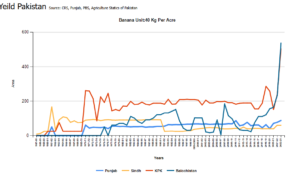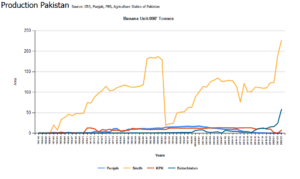Introduction
Bananas are one of the most important fruit crops in Pakistan, contributing significantly to the country’s agriculture and economy. Banana production in Pakistan plays a crucial role in the agricultural sector, providing economic benefits and nutritional value to millions. The production of bananas is mainly concentrated in Sindh, followed by Punjab, Khyber Pakhtunkhwa (KPK), and Balochistan. This article explores the significance of banana cultivation in Pakistan and analyzes the production and productivity trends over the years.
Nutritional and Economic Importance of Bananas
Bananas are highly nutritious, providing essential vitamins and minerals such as potassium, vitamin B6, vitamin C, and fiber. They serve as a staple fruit for many people and offer various health benefits, including improved digestion, heart health, and energy boosting. Economically, banana farming provides employment and income to many farmers, making it a key cash crop in Pakistan’s fruit sector.
Climate and Soil Requirements for Banana Cultivation
Banana cultivation thrives in warm, tropical, and subtropical climates with an optimal temperature range of 26°C to 30°C. The crop requires deep, well-drained, and loamy soil with a pH range of 5.5 to 7.5 for optimal growth. High humidity and consistent water availability are also critical factors in banana farming. In Pakistan, Sindh province provides ideal conditions for banana cultivation due to its warm climate and fertile land.
Major Banana Producing Areas in Pakistan
The primary banana-producing regions in Pakistan include:
- Sindh: Leading the country in banana production, particularly in districts like Thatta, Badin, Hyderabad, and Khairpur.
- Punjab: Although not a major producer, some banana farming occurs in districts like Multan and Rahim Yar Khan.
- Balochistan: The climate allows for banana cultivation, but production remains lower compared to Sindh.
- Khyber Pakhtunkhwa (KPK): Banana production is minimal due to the cooler climate and unsuitable soil conditions.
Banana Production Trends in Pakistan 2000 to 2023
The following table presents banana production trends across four provinces in Pakistan from 2000 to 2014:
| Year | Punjab | Sindh | KPK | Balochistan | Pakistan Total |
|---|---|---|---|---|---|
| 2000-01 | 17.4 | 101.7 | 12.2 | 8.1 | 139.4 |
| 2001-02 | 15.8 | 113.5 | 12.3 | 8.1 | 149.7 |
| 2002-03 | 14.7 | 112.9 | 12.2 | 3.1 | 142.9 |
| 2003-04 | 12.9 | 125.7 | 13.1 | 2.3 | 154.0 |
| 2004-05 | 12.4 | 129.6 | 13.1 | 2.9 | 158.0 |
| 2005-06 | 11.4 | 134.8 | 13.7 | 3.6 | 163.5 |
| 2006-07 | 10.4 | 126.3 | 13.6 | 0.2 | 150.5 |
| 2007-08 | 9.9 | 127.0 | 13.8 | 7.3 | 158.0 |
| 2008-09 | 9.5 | 128.9 | 13.2 | 5.7 | 157.3 |
| 2009-10 | 9.4 | 127.4 | 13.2 | 4.8 | 154.8 |
| 2010-11 | 10.3 | 113.4 | 12.6 | 4.9 | 141.2 |
| 2011-12 | 6.2 | 76.0 | 13.0 | 3.0 | 98.2 |
| 2012-13 | 4.3 | 121.2 | 13.1 | 2.7 | 141.3 |
| 2013-14 | 3.8 | 100.8 | 13.1 | 2.7 | 120.4 |
Challenges in Banana Production
Several challenges hinder the growth of banana production in Pakistan, including:
- Diseases and Pests: Panama disease, Fusarium wilt, and banana bunchy top virus (BBTV) pose serious threats to banana crops.
- Climate Change: Unpredictable weather patterns, droughts, and excessive rainfall negatively impact banana yields.
- Post-Harvest Losses: Lack of proper storage and transportation facilities leads to significant losses after harvesting.
- Water Scarcity: Inadequate irrigation facilities affect banana production, especially in regions with water shortages.


Future Prospects and Recommendations
To improve banana production and productivity in Pakistan, the following strategies can be implemented:
- Adoption of Disease-Resistant Varieties: Research institutions should develop and promote disease-resistant banana varieties.
- Improved Irrigation Techniques: Modern irrigation methods like drip irrigation should be introduced to optimize water use.
- Post-Harvest Management: Establishing cold storage facilities and better transportation systems can reduce post-harvest losses.
- Government Support: Policies that support banana farmers through subsidies, training, and financial assistance can enhance production.
Conclusion
Banana production and productivity in Pakistan have seen significant variations over the years. While Sindh remains the dominant producer, Punjab and Balochistan have faced fluctuations. Recent increases in productivity, particularly in 2022-23, indicate potential for growth, provided challenges like climate change and disease management are addressed effectively. With proper investments, technological advancements, and supportive government policies, banana farming can contribute even more to Pakistan’s economy and food security.
Agricultural Economics page follow
Download 50 years data area, productivity and production of banana of all provinces of Pakistan

